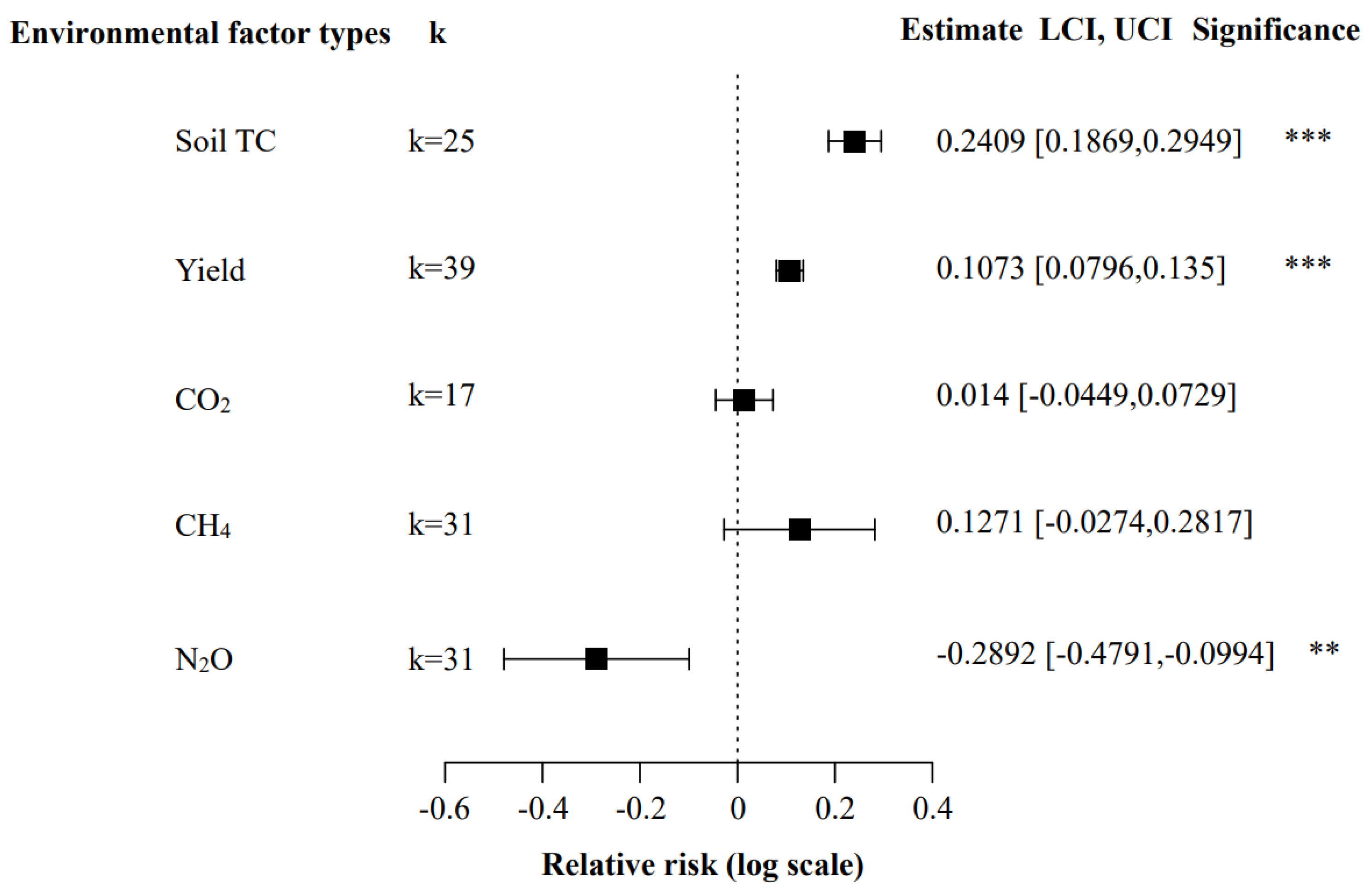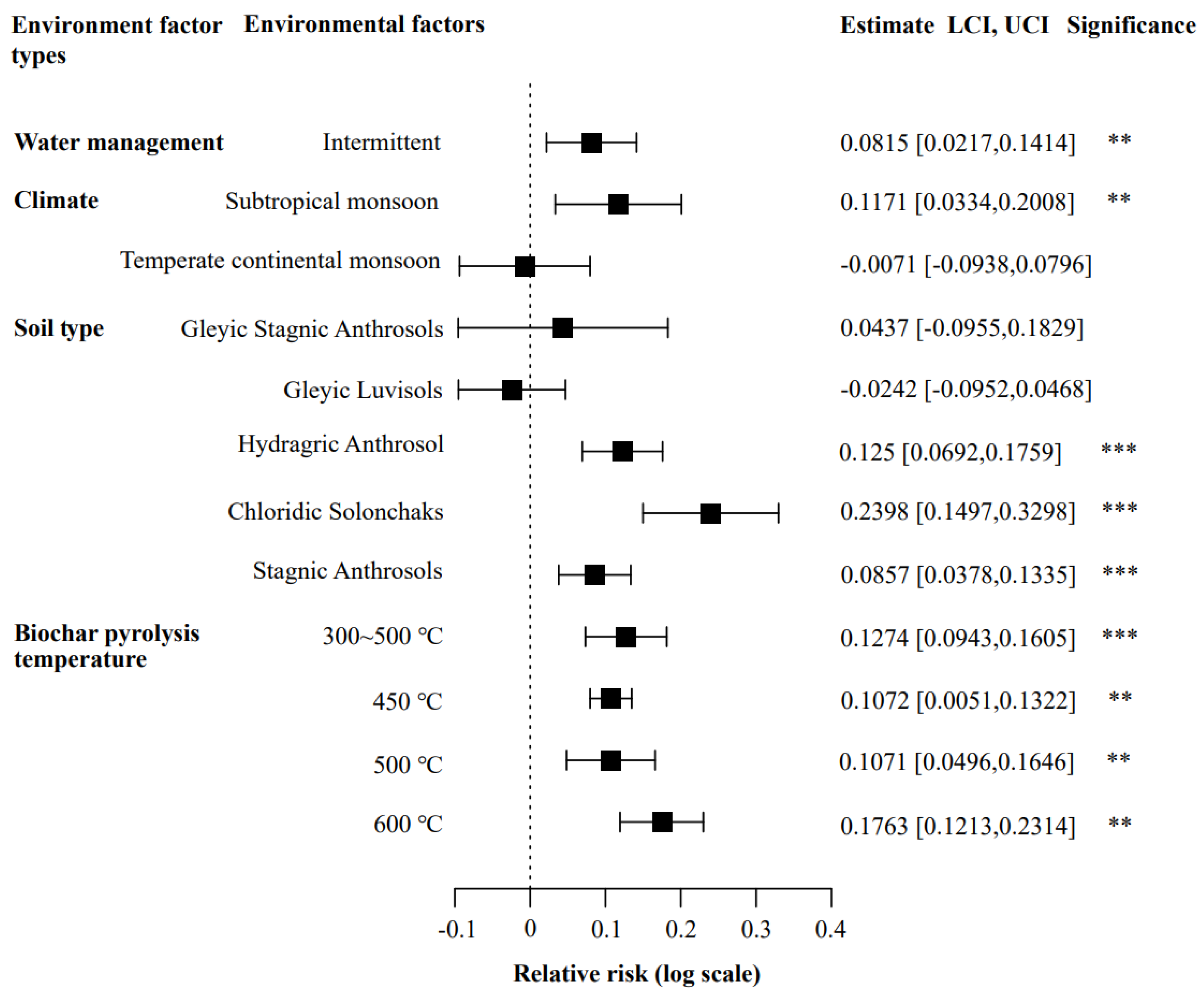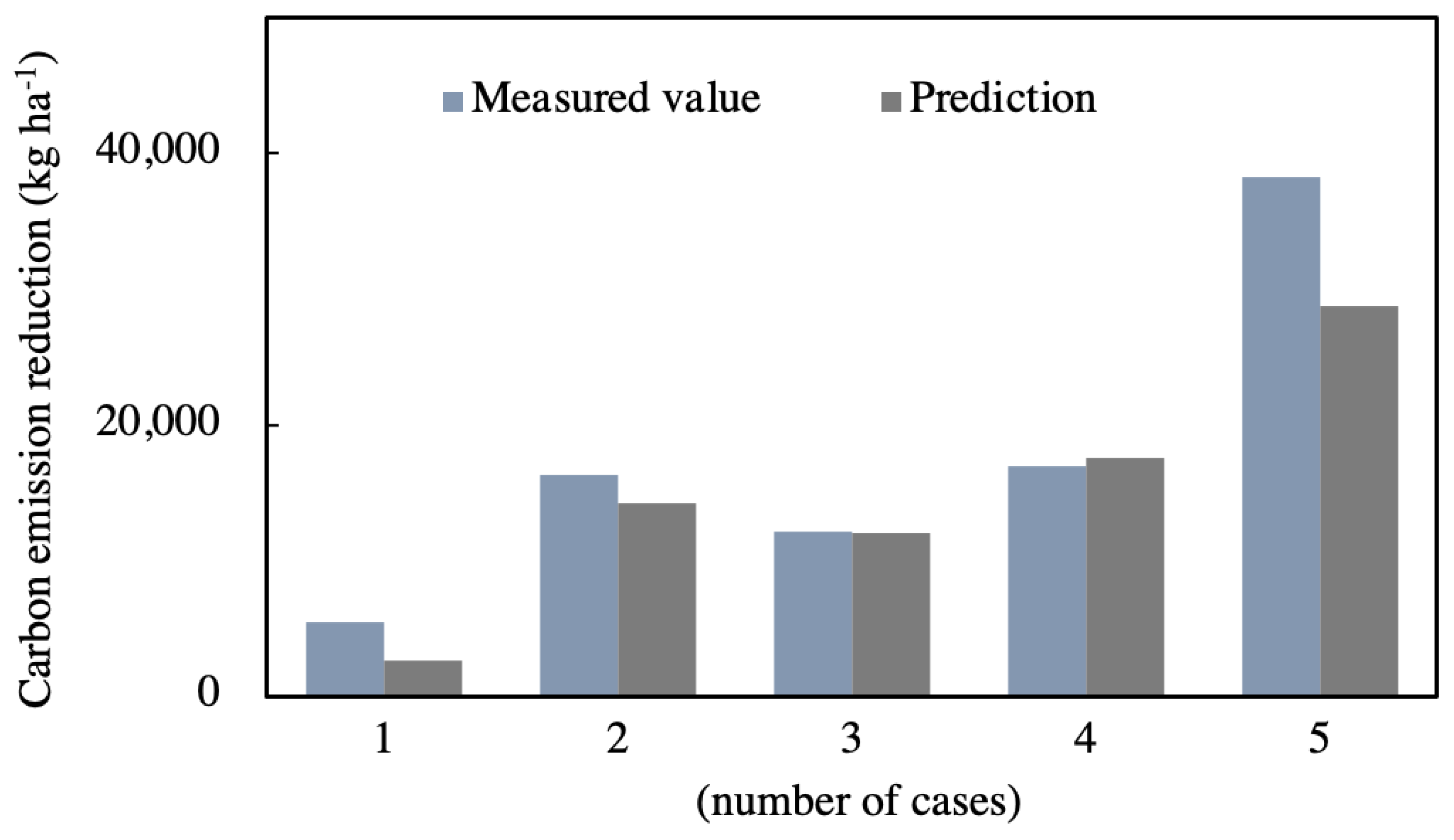Meta-Analysis for Quantifying Carbon Sequestration and Greenhouse Gas Emission in Paddy Soils One Year after Biochar Application
Abstract
1. Introduction
2. Materials and Methods
2.1. Data Collection and Meta-Analysis
2.2. Carbon Emission Calculation
2.3. Uncertainty Analysis
3. Results
3.1. Impact of Biochar on Carbon Emission Factors
3.2. Heterogeneity Analysis for Rice Yield Variation
3.3. Heterogeneity Analysis of Soil Total Carbon Variation
3.4. Heterogeneity Analysis for CO2 Emission
3.5. Heterogeneity Analysis of CH4 Emission
3.6. Heterogeneity Analysis of N2O Emission
3.7. Carbon Emission Correction Factors
3.8. Calculation of Net Carbon Emissions from Biochar-Amended Paddy Soils
4. Discussion
5. Conclusions
Supplementary Materials
Author Contributions
Funding
Institutional Review Board Statement
Informed Consent Statement
Data Availability Statement
Conflicts of Interest
References
- Wang, F.; Harindintwali, J.D.; Yuan, Z.; Wang, M.; Wang, F.; Li, S.; Yin, Z.; Huang, L.; Fu, Y.; Li, L.; et al. Technologies and perspectives for achieving carbon neutrality. Innovation 2021, 2, 100180. [Google Scholar] [CrossRef]
- Jia, Z.; Lin, B. How to achieve the first step of the carbon-neutrality 2060 target in China: The coal substitution perspective. Energy 2021, 233, 121179. [Google Scholar] [CrossRef]
- Zhao, X.; Ma, X.; Chen, B.; Shang, Y.; Song, M. Challenges toward carbon neutrality in China: Strategies and countermeasures. Resour. Conserv. Recycl. 2022, 176, 105959. [Google Scholar] [CrossRef]
- Smith, P. Soil carbon sequestration and biochar as negative emission technologies. Glob. Change Biol. 2016, 22, 1315–1324. [Google Scholar] [CrossRef]
- FAOSTAT Food and Agriculture Organization of the United Nations (FAO). Available online: http://www.fao.org/faostat/en/#data (accessed on 16 March 2020).
- Xiao, Y.; Yang, S.; Xu, J.; Ding, J.; Sun, X.; Jiang, Z. Effect of Biochar Amendment on Methane Emissions from Paddy Field under Water-Saving Irrigation. Sustainability 2018, 10, 1371. [Google Scholar] [CrossRef]
- Bridgham, S.D.; Cadillo-Quiroz, H.; Keller, J.K. Methane emissions from wetlands: Biogeochemical, microbial, and modeling perspectives from local to global scales. Glob. Change Biol. 2013, 19, 1325–1346. [Google Scholar] [CrossRef]
- Ma, K.E.; Qiu, Q.; Lu, Y. Microbial mechanism for rice variety control on methane emission from rice field soil. Glob. Change Biol. 2010, 16, 3085–3095. [Google Scholar] [CrossRef]
- Jiang, Y.; Qian, H.; Huang, S.; Zhang, X.; Wang, L.; Zhang, L.; Shen, M.; Xiao, X.; Chen, F.; Zhang, H.; et al. Acclimation of methane emissions from rice paddy fields to straw addition. Sci. Adv. 2019, 5, eaau9038. [Google Scholar] [CrossRef] [PubMed]
- Jeffery, S.; Verheijen, F.G.A.; Kammann, C.; Abalos, D. Biochar effects on methane emissions from soils: A meta-analysis. Soil Biol. Biochem. 2016, 101, 251–258. [Google Scholar] [CrossRef]
- Han, X.; Sun, X.; Wang, C.; Wu, M.; Dong, D.; Zhong, T.; Thies, J.E.; Wu, W. Mitigating methane emission from paddy soil with rice-straw biochar amendment under projected climate change. Sci. Rep. 2016, 6, 24731. [Google Scholar] [CrossRef]
- Wang, C.; Wang, W.; Sardans, J.; Singla, A.; Zeng, C.; Lai, D.Y.F.; Penuelas, J. Effects of steel slag and biochar amendments on CO2, CH4, and N2O flux, and rice productivity in a subtropical Chinese paddy field. Environ. Geochem. Health 2019, 41, 1419–1431. [Google Scholar] [CrossRef]
- Ji, C.; Jin, Y.; Li, C.; Chen, J.; Kong, D.; Yu, K.; Liu, S.; Zou, J. Variation in Soil Methane Release or Uptake Responses to Biochar Amendment: A Separate Meta-analysis. Ecosystems 2018, 21, 1692–1705. [Google Scholar] [CrossRef]
- Bouwman, A.F.; Boumans, L.J.M.; Batjes, N.H. Modeling global annual N2O and NO emissions from fertilized fields. Glob. Biogeochem. Cycles 2002, 16, 28-1–28-9. [Google Scholar] [CrossRef]
- Aamer, M.; Hassan, M.U.; Shaaban, M.; Rasul, F.; Haiying, T.; Qiaoying, M.; Batool, M.; Rasheed, A.; Chuan, Z.; Qitao, S.; et al. Rice straw biochar mitigates N2O emissions under alternate wetting and drying conditions in paddy soil. J. Saudi Chem. Soc. 2021, 25, 101172. [Google Scholar] [CrossRef]
- Xiao, L.; Feng, L.; Yuan, G.; Wei, J. Low-cost field production of biochars and their properties. Environ. Geochem. Health 2020, 42, 1569–1578. [Google Scholar] [CrossRef] [PubMed]
- Yi, Q.; Liang, B.; Nan, Q.; Wang, H.; Zhang, W.; Wu, W. Temporal physicochemical changes and transformation of biochar in a rice paddy: Insights from a 9-year field experiment. Sci. Total Environ. 2020, 721, 137670. [Google Scholar] [CrossRef] [PubMed]
- Nan, Q.; Wang, C.; Wang, H.; Yi, Q.; Liang, B.; Xu, J.; Wu, W. Biochar drives microbially-mediated rice production by increasing soil carbon. J. Hazard. Mater. 2020, 387, 121680. [Google Scholar] [CrossRef]
- IPCC. 2019 Refinement to the 2006 IPCC Guidelines for National Greenhouse Gas Inventories; IPCC: Geneva, Switzerland, 2019. [Google Scholar]
- Nan, Q.; Xin, L.; Qin, Y.; Waqas, M.; Wu, W. Exploring long-term effects of biochar on mitigating methane emissions from paddy soil: A review. Biochar 2021, 3, 125–134. [Google Scholar] [CrossRef]
- Nan, Q.; Wang, C.; Wang, H.; Yi, Q.; Wu, W. Mitigating methane emission via annual biochar amendment pyrolyzed with rice straw from the same paddy field. Sci. Total Environ. 2020, 746, 141351. [Google Scholar] [CrossRef]
- Yang, S.H.; Xiao, Y.N.; Sun, X.; Ding, J.; Jiang, Z.W.; Xu, J.Z. Biochar improved rice yield and mitigated CH4 and N2O emissions from paddy field under controlled irrigation in the Taihu Lake Region of China. At. Environ. 2019, 200, 69–77. [Google Scholar] [CrossRef]
- Xu, X.; He, C.; Yuan, X.; Zhang, Q.; Wang, S.; Wang, B.; Guo, X.; Zhang, L. Rice straw biochar mitigated more N2O emissions from fertilized paddy soil with higher water content than that derived from ex situ biowaste. Environ. Pollut. 2020, 263, 114477. [Google Scholar] [CrossRef]
- Cui, Y.; Meng, J.; Wang, Q.; Zhang, W.; Cheng, X.; Chen, W. Effects of straw and biochar addition on soil nitrogen, carbon, and super rice yield in cold waterlogged paddy soils of North China. J. Integr. Agric. 2017, 16, 1064–1074. [Google Scholar] [CrossRef]
- Chen, D.; Wang, C.; Shen, J.; Li, Y.; Wu, J. Response of CH4 emissions to straw and biochar applications in double-rice cropping systems: Insights from observations and modeling. Environ. Pollut. 2018, 235, 95–103. [Google Scholar] [CrossRef] [PubMed]
- Sun, L.; Deng, J.; Fan, C.; Li, J.; Liu, Y. Combined effects of nitrogen fertilizer and biochar on greenhouse gas emissions and net ecosystem economic budget from a coastal saline rice field in southeastern China. Environ. Sci. Pollut. Res. 2020, 27, 17013–17022. [Google Scholar] [CrossRef]
- Zhang, A.; Bian, R.; Hussain, Q.; Li, L.; Pan, G.; Zheng, J.; Zhang, X.; Zheng, J. Change in net global warming potential of a rice–wheat cropping system with biochar soil amendment in a rice paddy from China. Agric. Ecosyst. Environ. 2013, 173, 37–45. [Google Scholar] [CrossRef]
- Zhang, A.; Bian, R.; Pan, G.; Cui, L.; Hussain, Q.; Li, L.; Zheng, J.; Zheng, J.; Zhang, X.; Han, X.; et al. Effects of biochar amendment on soil quality, crop yield and greenhouse gas emission in a Chinese rice paddy: A field study of 2 consecutive rice growing cycles. Field Crops Res. 2012, 127, 153–160. [Google Scholar] [CrossRef]
- Zhang, A.; Cui, L.; Pan, G.; Li, L.; Hussain, Q.; Zhang, X.; Zheng, J.; Crowley, D. Effect of biochar amendment on yield and methane and nitrous oxide emissions from a rice paddy from Tai Lake plain, China. Agric. Ecosyst. Environ. 2010, 139, 469–475. [Google Scholar] [CrossRef]
- ISO 14044:2006; Environmental Management—Life Cycle Assessment—Requirements and Guidelines 2006. International Organization for Standardization: Geneva, Switzerland, 2006.
- Biederman, L.A.; Harpole, W.S. Biochar and its effects on plant productivity and nutrient cycling: A meta-analysis. GCB Bioenergy 2013, 5, 202–214. [Google Scholar] [CrossRef]
- Viechtbauer, W. Conducting Meta-Analyses in R with the metafor Package. J. Stat. Softw. 2010, 36, 1–48. [Google Scholar] [CrossRef]
- Chen, G.; Fang, Y.; Van Zwieten, L.; Xuan, Y.; Tavakkoli, E.; Wang, X.; Zhang, R. Priming, stabilization and temperature sensitivity of native SOC is controlled by microbial responses and physicochemical properties of biochar. Soil Biology Biochem. 2021, 154, 108139. [Google Scholar] [CrossRef]
- Brassard, P.; Godbout, S.; Pelletier, F.; Raghavan, V.; Palacios, J.H. Pyrolysis of switchgrass in an auger reactor for biochar production: A greenhouse gas and energy impacts assessment. Biomass Bioenergy 2018, 116, 99–105. [Google Scholar] [CrossRef]
- EBC. EBC-Guidelines for the Certification of Biochar Based Carbon Sinks Version 2.1 from 1 February 2021. 2020. Available online: http://European-biochar.org (accessed on 30 September 2022).
- China, National Bureau of Satistics of China. Available online: http://www.stats.gov.cn/tjsj/ndsj/2021/indexch.htm (accessed on 30 September 2022).
- Liu, Y.; Chen, Y.; Wang, Y.; Lu, H.; He, L.; Yang, S. Negative priming effect of three kinds of biochar on the mineralization of native soil organic carbon. Land Degrad. Dev. 2018, 29, 3985–3994. [Google Scholar] [CrossRef]
- Lu, W.; Ding, W.; Zhang, J.; Li, Y.; Luo, J.; Bolan, N.; Xie, Z. Biochar suppressed the decomposition of organic carbon in a cultivated sandy loam soil: A negative priming effect. Soil Biol. Biochem. 2014, 76, 12–21. [Google Scholar] [CrossRef]
- Awad, Y.M.; Wang, J.; Igalavithana, A.D.; Tsang, D.C.W.; Kim, K.-H.; Lee, S.S.; Ok, Y.S. Chapter One—Biochar Effects on Rice Paddy: Meta-analysis. In Advances in Agronomy; Sparks, D.L., Ed.; Academic Press: Cambridge, MA, USA, 2018; Volume 148, pp. 1–32. [Google Scholar]
- Liu, X.; Ma, Y.; Manevski, K.; Andersen, M.N.; Li, Y.; Wei, Z.; Liu, F. Biochar and alternate wetting-drying cycles improving rhizosphere soil nutrients availability and tobacco growth by altering root growth strategy in Ferralsol and Anthrosol. Sci. Total Environ. 2022, 806, 150513. [Google Scholar] [CrossRef] [PubMed]
- Wu, W.; Yang, M.; Feng, Q.; McGrouther, K.; Wang, H.; Lu, H.; Chen, Y. Chemical characterization of rice straw-derived biochar for soil amendment. Biomass Bioenergy 2012, 47, 268–276. [Google Scholar] [CrossRef]
- Khadem, A.; Raiesi, F.; Besharati, H.; Khalaj, M.A. The effects of biochar on soil nutrients status, microbial activity and carbon sequestration potential in two calcareous soils. Biochar 2021, 3, 105–116. [Google Scholar] [CrossRef]
- Wu, Z.; Song, Y.; Shen, H.; Jiang, X.; Li, B.; Xiong, Z. Biochar can mitigate methane emissions by improving methanotrophs for prolonged period in fertilized paddy soils. Environ. Pollut. 2019, 253, 1038–1046. [Google Scholar] [CrossRef]
- Nan, Q.; Fang, C.; Cheng, L.; Hao, W.; Wu, W. Elevation of NO3−-N from biochar amendment facilitates mitigating paddy CH4 emission stably over seven years. Environ. Pollut. 2021, 295, 118707. [Google Scholar] [CrossRef]
- Luo, J.; Huang, J.; Zeng, D.; Peng, J.; Zhang, G.; Ma, H.; Guan, Y.; Yi, H.; Fu, Y.; Han, B.; et al. A defensin-like protein drives cadmium efflux and allocation in rice. Nat. Commun. 2018, 9, 645. [Google Scholar] [CrossRef]
- Ji, C.; Li, S.; Geng, Y.; Yuan, Y.; Zhi, J.; Yu, K.; Han, Z.; Wu, S.; Liu, S.; Zou, J. Decreased N2O and NO emissions associated with stimulated denitrification following biochar amendment in subtropical tea plantations. Geoderma 2020, 365, 114223. [Google Scholar] [CrossRef]
- Aamer, M.; Shaaban, M.; Hassan, M.U.; Ying, L.; Haiying, T.; Qiaoying, M.; Munir, H.; Rasheed, A.; Xinmei, L.; Ping, L.; et al. N2O Emissions Mitigation in Acidic Soil Following Biochar Application Under Different Moisture Regimes. J. Soil Sci. Plant Nutr. 2020, 20, 2454–2464. [Google Scholar] [CrossRef]
- Yue, Q.; Ledo, A.; Cheng, K.; Albanito, F.; Lebender, U.; Sapkota, T.B.; Brentrup, F.; Stirling, C.M.; Smith, P.; Sun, J.; et al. Re-assessing nitrous oxide emissions from croplands across Mainland China. Agric. Ecosyst. Environ. 2018, 268, 70–78. [Google Scholar] [CrossRef]
- Yang, Q.; Zhou, H.; Bartocci, P.; Fantozzi, F.; Mašek, O.; Agblevor, F.A.; Wei, Z.; Yang, H.; Chen, H.; Lu, X.; et al. Prospective contributions of biomass pyrolysis to China’s 2050 carbon reduction and renewable energy goals. Nat. Commun. 2021, 12, 1698. [Google Scholar] [CrossRef] [PubMed]
- van der Velde, M.; Folberth, C.; Balkovič, J.; Ciais, P.; Fritz, S.; Janssens, I.A.; Obersteiner, M.; See, L.; Skalský, R.; Xiong, W.; et al. African crop yield reductions due to increasingly unbalanced Nitrogen and Phosphorus consumption. Glob. Change Biol. 2014, 20, 1278–1288. [Google Scholar] [CrossRef]
- Xu, X.; Cheng, K.; Wu, H.; Sun, J.; Yue, Q.; Pan, G. Greenhouse gas mitigation potential in crop production with biochar soil amendment—A carbon footprint assessment for cross-site field experiments from China. GCB Bioenergy 2019, 11, 592–605. [Google Scholar] [CrossRef]




| Environmental Factor Types | QM | PQM | k |
|---|---|---|---|
| Biochar amount | 3.2139 | 0.073 | 39 |
| Biochar temperature | 10.8249 | 0.0286 | 37 |
| Biochar material | 4.7397 | 0.0935 | 37 |
| Soil type | 47.8961 | <0.0001 | 39 |
| Climate | 40.4763 | <0.0001 | 37 |
| Water management | 7.1269 | 0.0076 | 35 |
| Environmental Factor Types | QM | PQM | Significance | k |
|---|---|---|---|---|
| Biochar amount | 16.1367 | <0.0001 | *** | 25 |
| Raw material | 4.41 | 0.1103 | 25 | |
| Biochar temperature | 7.6371 | 0.1058 | 25 | |
| Soil type | 7.4562 | 0.1889 | 25 | |
| Climate | 0.6096 | 0.435 | 25 | |
| Water management | 0.0048 | 0.9448 | 23 |
| Environmental Factor Types | QM | PQM | k |
|---|---|---|---|
| Biochar amount | 1.8279 | 0.1764 | 17 |
| Raw material | 5.379 | 0.0679 | 15 |
| Soil type | 4.0161 | 0.2597 | 17 |
| Climate | 3.997 | 0.0456 | 17 |
| Water management | 3.2422 | 0.0718 | 13 |
| Environmental Factor Types | QM | PQM | k |
|---|---|---|---|
| Biochar amount | 0.1271 | 0.2817 | 31 |
| Raw material | 1.3656 | 0.5052 | 31 |
| Soil type | 7.3851 | 0.2867 | 31 |
| Climate | 3.1852 | 0.0743 | 31 |
| Water management | 0.3698 | 0.5431 | 25 |
| N | 18.0088 | 0.0212 | 31 |
| P | 12.3697 | 0.1355 | 31 |
| K | 12.7907 | 0.0774 | 31 |
| Environmental Factor Types | QM | PQM | k |
|---|---|---|---|
| Biochar amount | 0.4801 | 0.4884 | 31 |
| Raw material | 5.0767 | 0.079 | 31 |
| Climate | 0.115 | 0.7346 | 31 |
| Water management | 0.8517 | 0.3561 | 25 |
| N | 2.3091 | 0.8892 | 31 |
| P | 33.027 | < 0.0001 | 31 |
| K | 31.1186 | < 0.0001 | 31 |
| Items | Environmental Factor Types | Environmental Factors | Correction Coefficients |
|---|---|---|---|
| Yield | Water management | Intermittent | 0.98 |
| Climate | Subtropical monsoon | 1.02 | |
| Temperate continental monsoon | 1 | ||
| Soil type | Gleyic Stagnic Anthrosols | 1 | |
| Gleyic Luvisols | 1 | ||
| Hydragric Anthrosols | 1.02 | ||
| Chloridic Solonchaks | 1.18 | ||
| Stagnic Anthrosols | 0.98 | ||
| Biochar temperature (°C) | 300~350 | 1.03 | |
| 450 | 1.01 | ||
| 500 | 1.01 | ||
| 600 | 1.09 | ||
| CO2 | Climate | Temperate continental monsoon | 1.09 |
| CH4 | N (kg ha−1) | 200 | 1 |
| 210 | 0.42 | ||
| 250 | 1 | ||
| 270 | 1 | ||
| 273 | 1 | ||
| 292.8 | 1 | ||
| 300 | 1 | ||
| 456 | 1 | ||
| N2O | Soil type | Gleyic Stagnic Anthrosols | 1 |
| Gleyic Luvisols | 1 | ||
| Hydragric Anthrosols | 1 | ||
| Chloridic Solonchaks | 1 | ||
| Stagnic Anthrosols | 1 | ||
| P (kg ha−1) | 60 | 1 | |
| 90 | 1 | ||
| 120 | 0.6 | ||
| 125 | 1 | ||
| 204 | 1 | ||
| 875 | 1 | ||
| K (kg ha−1) | 63.5 | 2.96 | |
| 120 | 4.33 | ||
| 125 | 1 | ||
| 202 | 1 | ||
| 204 | 2.26 |
Publisher’s Note: MDPI stays neutral with regard to jurisdictional claims in published maps and institutional affiliations. |
© 2022 by the authors. Licensee MDPI, Basel, Switzerland. This article is an open access article distributed under the terms and conditions of the Creative Commons Attribution (CC BY) license (https://creativecommons.org/licenses/by/4.0/).
Share and Cite
Bu, F.; Nan, Q.; Li, W.; Bolan, N.; Sarkar, B.; Meng, J.; Wang, H. Meta-Analysis for Quantifying Carbon Sequestration and Greenhouse Gas Emission in Paddy Soils One Year after Biochar Application. Agronomy 2022, 12, 3065. https://doi.org/10.3390/agronomy12123065
Bu F, Nan Q, Li W, Bolan N, Sarkar B, Meng J, Wang H. Meta-Analysis for Quantifying Carbon Sequestration and Greenhouse Gas Emission in Paddy Soils One Year after Biochar Application. Agronomy. 2022; 12(12):3065. https://doi.org/10.3390/agronomy12123065
Chicago/Turabian StyleBu, Fei, Qiong Nan, Wushuang Li, Nanthi Bolan, Binoy Sarkar, Jun Meng, and Hailong Wang. 2022. "Meta-Analysis for Quantifying Carbon Sequestration and Greenhouse Gas Emission in Paddy Soils One Year after Biochar Application" Agronomy 12, no. 12: 3065. https://doi.org/10.3390/agronomy12123065
APA StyleBu, F., Nan, Q., Li, W., Bolan, N., Sarkar, B., Meng, J., & Wang, H. (2022). Meta-Analysis for Quantifying Carbon Sequestration and Greenhouse Gas Emission in Paddy Soils One Year after Biochar Application. Agronomy, 12(12), 3065. https://doi.org/10.3390/agronomy12123065





